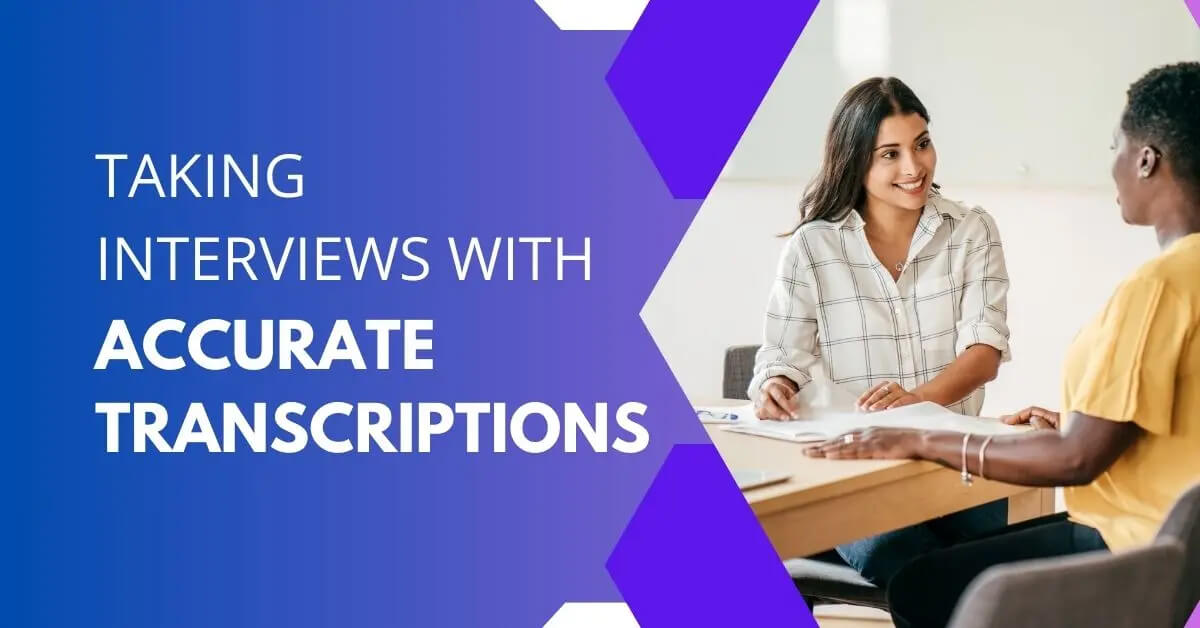Taking Interviews With Accurate Transcriptions
As the world becomes increasingly digital, the way businesses and organizations conduct interviews is also changing. Many companies now opt for remote interviews, which can be conducted via video conferencing apps or over the phone. While these methods have their benefits, they also pose unique challenges when it comes to accurately transcribing the interviews. In this article, we'll explore some tips and tricks for taking interviews with accurate transcriptions, whether they're conducted in person or remotely.
5 Tips For Taking Interviews With Accurate Transcriptions
Interviews are an essential part of gathering information and insights about a particular subject. However, taking accurate transcriptions during interviews can be difficult. Let's have a look at five tips for taking interviews with accurate transcriptions:
Plan What You Will Ask
Before starting the discussion, you have to clearly understand what you want to ask. This is the key to effortless transcription later on and a smooth, fluent interview. It will help you stay on track and avoid asking irrelevant questions. Preparing a list of questions or topics to cover can help you gather all vital information.
Ask Broad Questions
Open-ended questions allow the interviewee to elaborate and provide detailed responses. This approach encourages detailed replies and yields valuable information for your transcript. If you let the interviewees express themselves freely, you create a richer, more detailed transcript with a deeper understanding of your subject matter.
Make Sure The Interviewee Understands Your Questions
Be precise, articulate, and structure the questions so that they are easily understood. Avoid using jargon to ensure the interviewee can provide informed and accurate responses. Clear, concise questions help prevent vague or incomplete answers, which can make transcription challenging.
Give Proper Time To Reply
Allow the interviewee enough time to fully answer each question. Interrupting or finishing their words can disrupt the natural flow of conversation and hinder the accuracy of the transcript. Giving them sufficient time to express their thoughts will help capture the substance of their ideas.
Ask Follow-up Questions
Thoughtful follow-up questions can elicit valuable information and add depth to your transcript. Skilled transcribers can capture these nuances, ensuring the transcript remains accurate and insightful.
How Can You Transcribe An Interview Correctly?
Transcribing an interview is an essential part of journalism, research, and content creation. A transcription is a written record of what was said during an interview.

A poorly transcribed interview can lead to factual errors and misrepresentations. Let's take a look at some tips to transcribe an interview correctly:
Listen To The Interview Recording
Review the entire recording from start to finish before deciding on a transcription approach. Consider the number of participants, the duration of the recording, and any specialized terminology. This helps in deciding whether to transcribe the entire discussion or just a portion.
Figure Out How Much Time Will Be Required
Study the recording to determine the time required for transcription based on the number of participants, duration, and complexity of the terminology.
Use The Right Tools
Headphones, a computer, and a text editor are essential for transcription. AI-powered transcription tools can save time and improve accuracy, especially for legal documents or qualitative research.
Use Shortcut Methods
Text editors with auto-correct and auto-complete features can help save time. However, be mindful of potential errors in auto-complete that can confuse similar words with different meanings.
Proofread
Review your transcript thoroughly to catch any mistakes. Proofreading is essential, as even the best transcription programs can make small errors.
Format The Transcript
Once you've made corrections, format the transcript properly by dividing it into paragraphs, using speaker names, and including timestamps. This will help keep the transcript organized and easy to follow.
Conclusion
Accurate transcriptions of interviews are crucial to ensure that important information is not lost or misinterpreted. Taking time to follow effective techniques can greatly enhance the quality of the final transcript, whether it's for a news story, academic paper, or business report.


